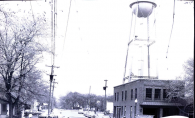
A collection of letters and handwriting samples Carolyn Porter has collected over the years. It was Marcel’s handwriting that first attracted her to his letters.
Carolyn Porter could never have predicted that a brief stop in a Stillwater antique shop would thrust her down a decade-long journey full of heart-pounding twists and turns, plunge her back in time, and end up changing her life forever.
Something about a stack of old yellowed postcards swirled with cascading letters written in French caught her attention. A graphic designer, she’d always been infatuated with calligraphy and the shapes of letters. She paid the apathetic teenager behind the counter and walked out with what was, unbeknownst to both of them, a treasure.
“For years I had wanted to capture the essence of century-old handwriting in a font,” Porter says. “I knew when I was standing in that store that those letters would be the basis of my new project.”
Porter spent her nights and weekends deconstructing the upper- and lower-case letters and numbers, as a creative respite from designing medical brochures.
Although she didn’t read or speak French, she could tell the letters were formed with care. Picking out bits and pieces, she grasped a few details: Paris, cinema, 1300 km. These vague facts caught her attention and, nearly a decade after first laying eyes on the postcards at the Stillwater antique store, she had one translated.
“I just assumed the postcards were a man writing to a woman,” she notes. But the first three words changed that. They were addressed to “My little darlings”—who turned out to be the writer’s three daughters.
His words were filled with tenderness and love. “As for Lily,” he writes, “I’m glad that she’s no longer sucking her thumb. I recommend that she doesn’t pick the blossoms from the cherry tree or the pear trees. She should wait until the fruit is ripe.” He signed his note “Your dad who thinks about you all the time, Papa.”
Because the first postcard didn’t include many details about this man or why he was separated from his family, Porter opted to get the second letter translated, too.
“Today marks the 14th month of my imprisonment,” reads the first line of the letter.
With that, Porter became obsessed with finding answers. Working with an archivist and genealogy researcher, she slowly put together pieces of the puzzle.
She learned the mystery man’s name was Marcel Heuzé, an ordinary French civilian living in a farming village southwest of Paris. He was sent to Germany to work as a forced laborer in World War II.
Marcel was part of the Service du travail obligatoire (compulsory work service), or STO, an often forgotten group in history. Germans needed laborers to replace men who had been transferred to the fronts to fight, so they demanded workers from the countries they occupied.
“As soon as we leave the table we are hungry again,” Marcel wrote to his wife in one of the letters. “What we eat doesn’t stick to our ribs.”
“At first, I just wanted to learn if Marcel survived and made it home—back to his daughters and wife,” Porter says. But the more she learned, the more unlikely that became. “Americans were bombing the factory where he worked. What would the Allies want to bomb more than a German factory?”
Porter did learn Marcel’s fate—and made some surprising connections in France. But we’ll let you read about that in her upcoming book: Marcel’s Letters: A Font and the Search for One Man’s Fate.
Both her book and the font, called Marcel, are getting rave reviews. Since its release, P22 Marcel Script has won five awards, including the certificate for typographic excellence from the New York Type Director’s Club—kind of like a rookie baseball player hitting a homerun his first time up to bat.
“I felt this huge responsibility to make the font beautiful. These letters weren’t just proof of love, they were proof of life,” Porter says. “I wanted the font to be worthy of those words of love. To be worthy of the high stakes—that every letter might have been his last.”
Porter has made an effort to be more emotionally expressive now, after learning the high stakes that Marcel had to go through to make sure his wife and daughters knew he loved them.
“The day I bought those letters, I couldn’t conceive what it would become,” she says. “I had no idea what I was buying or how it would change my life.”
Hear Carolyn Porter share Marcel’s story:
June 22, 7 p.m.
Subtext Books, St. Paul
June 26, 6 p.m.
A presentation at the White Bear Lake public library in conjunction with the White Bear Lake Area Historical Society.
July 14, 10-11:30 a.m.
Book signing at the WBL Farmers Market/Lake Country Booksellers
Marcel’s Letters: A Font and the Search for One Man’s Fate will be available in hardcover and eBook format when it is released in June. Pre-sales are underway online at Amazon and at barnesandnoble.com, as well as Lake Country Booksellers when it is released. For more information, visit the website here.









